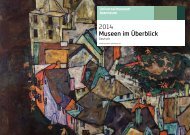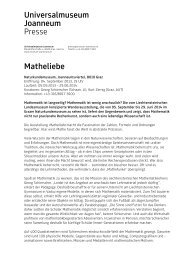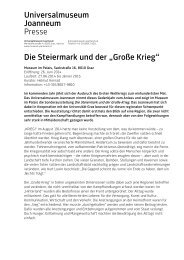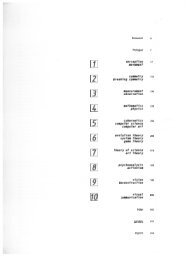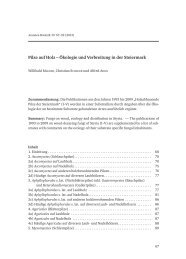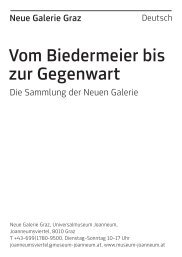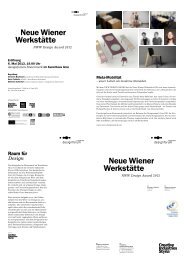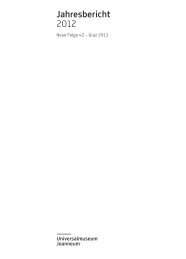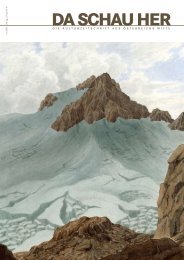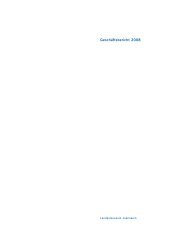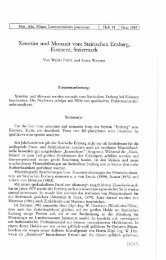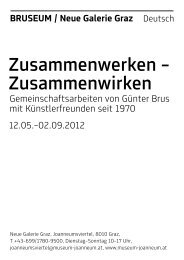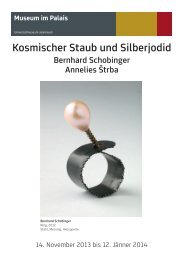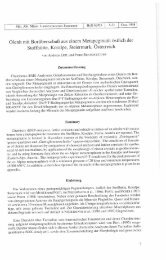Diana Thater gorillagorillagorilla - Universalmuseum Joanneum
Diana Thater gorillagorillagorilla - Universalmuseum Joanneum
Diana Thater gorillagorillagorilla - Universalmuseum Joanneum
Sie wollen auch ein ePaper? Erhöhen Sie die Reichweite Ihrer Titel.
YUMPU macht aus Druck-PDFs automatisch weboptimierte ePaper, die Google liebt.
in sich birgt, etwas zu verhandeln, oder, um <strong>Thater</strong>s eigene<br />
Worte zu verwenden, eine komplexere und tiefere Bedeutung<br />
von (ursprünglicher) Zeit und (ursprünglichem) Raum, jenseits<br />
aller historischen und mythischen Dimension, zu formen. Ein als<br />
Struktur verstandener Rhythmus nimmt die Rolle eines Agenten<br />
an, dessen Multitasking-Mission darin besteht, unartikulierte und<br />
unwandelbare natürliche Materie zu orchestrieren, wie eingangs<br />
von Agamben in seinem Verweis auf Aristoteles ausgeführt,<br />
und somit auch auf den Sophisten Antiphon, für den die Natur<br />
das erste und nicht reduzierbare Element ohne Form und ohne<br />
Struktur war. <strong>Diana</strong> <strong>Thater</strong> untersucht das Elementare und<br />
erforscht die nicht narrativen Eigenschaften der Natur, indem sie<br />
performative Arrangements von fast musikalischer Klarheit und<br />
Präzision komponiert. Hölderlins „Alles ist Rhythmus“ ließe sich<br />
als <strong>Thater</strong>s religiöses Bekenntnis betrachten, was ihren Rhythmus<br />
betrifft. Das sehr komplementäre Element Natur markiert die<br />
Potenzialität einer Erzählung und fungiert als Instrument zur<br />
Erzeugung einer „dynamischen Situation“7, in der alle verstreuten<br />
Elemente eine Koexistenz eingehen und eines mit dem anderen/<br />
in das andere mutiert, damit ein eigentlicher Status als Ganzes<br />
im Sinne Agambens zustande kommt. Struktur, behauptet die<br />
Künstlerin, sei ein Träger einer solchen Erzählung8, ein Sender<br />
und Garant für Kohärenz und Linearität.<br />
I.<br />
Strukturmuster<br />
Ihre Mehrkanal-Tour-de-Force China (1995) bezeichnet <strong>Diana</strong><br />
<strong>Thater</strong> als neostrukturalistische Installation, in der das formale<br />
Erbe der frühen Videoinstallationskunst sowie die parallel verlaufende<br />
Entwicklung des Structural Film (und hier vor allem die<br />
Arbeit von Hollis Frampton) ihren tiefsten Ausdruck finden9. Im<br />
Kino der Struktur ist die Form des gesamten Films vorbestimmt<br />
und vereinfacht. Und genau diese Form repräsentiert den<br />
primären Ausdruck des Films. Nach P. Adams Sitney nähert sich<br />
der Structural Film dem Zustand der Meditation und evoziert<br />
Bewusstseinszustände ohne Meditation, d.h. einzig mithilfe<br />
der Mediation der Kamera.10 Was in den Vordergrund tritt, ist<br />
mehr ein Kino der Gedanken als ein Kino des Auges mit seinen<br />
Wahrnehmungsstrategien. Alle vier von Sitney aufgezählten<br />
typischen Aspekte des Structural Film sind in der Tat Instrumente<br />
des Rhythmus: starre Kameraposition (statischer Rahmen aus<br />
der Zuschauerperspektive), Flimmereffekt, serielle Wiederholung<br />
und Reprofotografie von der Leinwand.11 <strong>Thater</strong> dynamisiert<br />
ein solches Schema weiter, indem sie die ganze Strategie und<br />
ihr reduziertes asketisches Vokabular rhythmisiert und dabei<br />
Adam Budak 14 15<br />
sculpting a more complex and profound sense of<br />
(original) time and space, beyond any historical and<br />
mythic dimensions. Rhythm understood as a structure<br />
takes on the role of an agent whose multitasking<br />
mission is to orchestrate an inarticulate and immutable<br />
matter of nature, as previously explained by Agamben<br />
in his reference to Aristotle and, consequently, to the<br />
sophist Antiphon who perceived nature as the prime<br />
and irreducible element, with neither shape nor<br />
structure. <strong>Diana</strong> <strong>Thater</strong> investigates the elemental and<br />
explores the non-narrative quality of nature, composing<br />
performative arrangements of almost musical clarity<br />
and precision. Hölderlin’s “everything is rhythm” might<br />
be considered <strong>Thater</strong>’s religion, as for her, the rhythm,<br />
the very complementary element of nature, marks<br />
the potentiality of a narrative and acts as a tool to<br />
a generate “dynamic situation”7 where all dispersed<br />
elements begin to cohabit and mutate one with/<br />
into the another in order to get a proper status as an<br />
ensemble in the Agambenian sense. Structure, as the<br />
artist claims, is a vehicle for such a narrative8, a transmitter<br />
and a guarantee of coherence and linearity.<br />
I.<br />
structural pattern<br />
<strong>Thater</strong>’s multi-channel tour-de-force, China (1995) is<br />
considered by the artist as a neo-structuralist installation<br />
where the formal legacy of early video installation<br />
as well as its parallel history of structuralist film (and<br />
mainly the work of Hollis Frampton) find the most<br />
profound expression.9 In the cinema of structure the<br />
shape of the whole film is predetermined and simplified,<br />
and it is that shape which is the primal impression of<br />
the film. According to P. Adams Sitney, the structural<br />
film approaches the condition of meditation and<br />
evokes states of consciousness without mediation;<br />
that is with the sole mediation of the camera.10<br />
It is a cinema of the mind rather than the eye with<br />
appercep tive strategies that come to the fore. All of<br />
the four aspects typical for the structuralist film, as<br />
enumerated by Sitney, are in fact the instruments of<br />
rhythm: fixed camera position (fixed frame from the<br />
viewer’s perspective), the flicker effect, loop printing<br />
and rephotography off the screen.11 <strong>Thater</strong> further<br />
dynamizes such a scheme by rhythmisizing the entire



